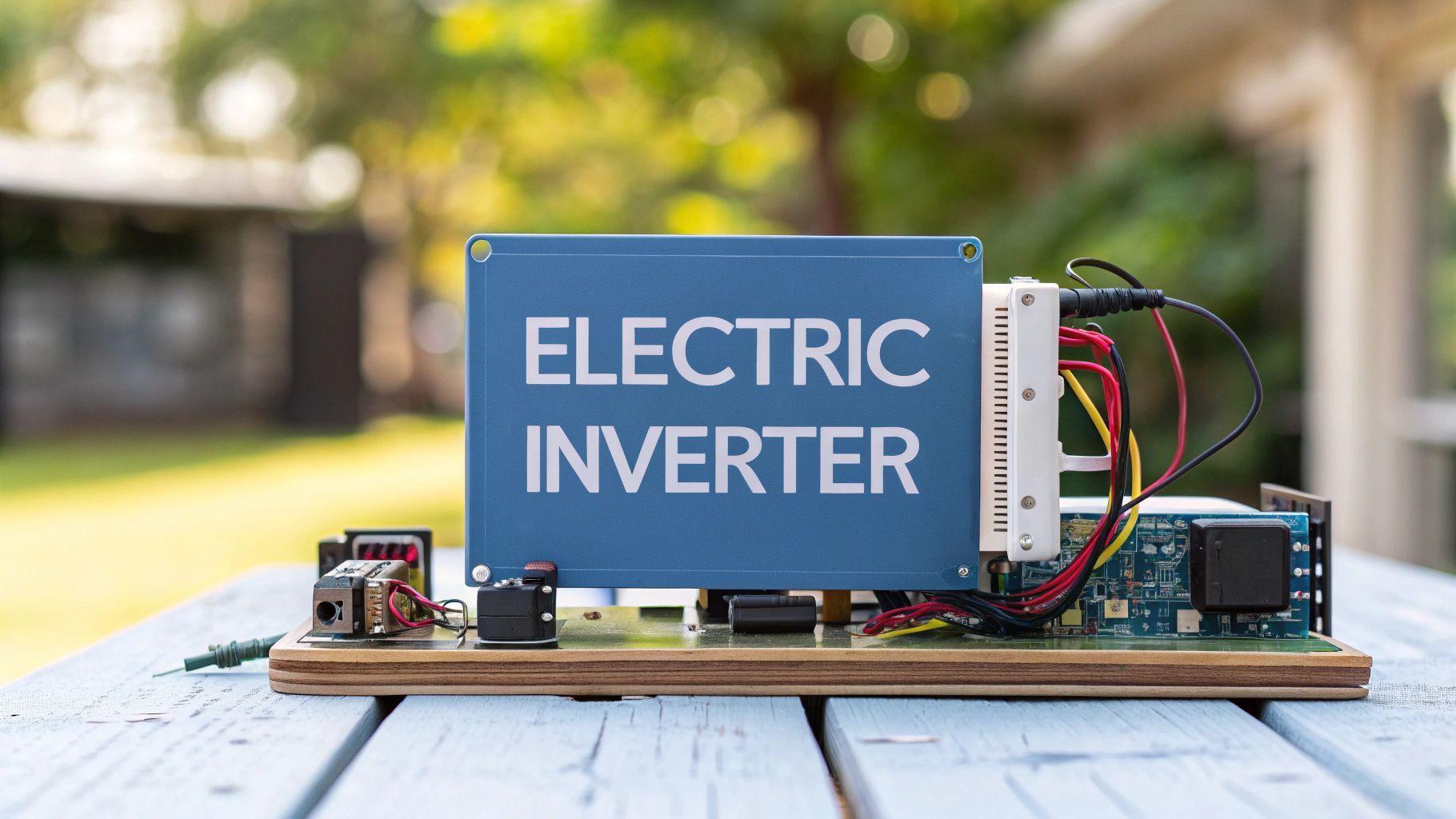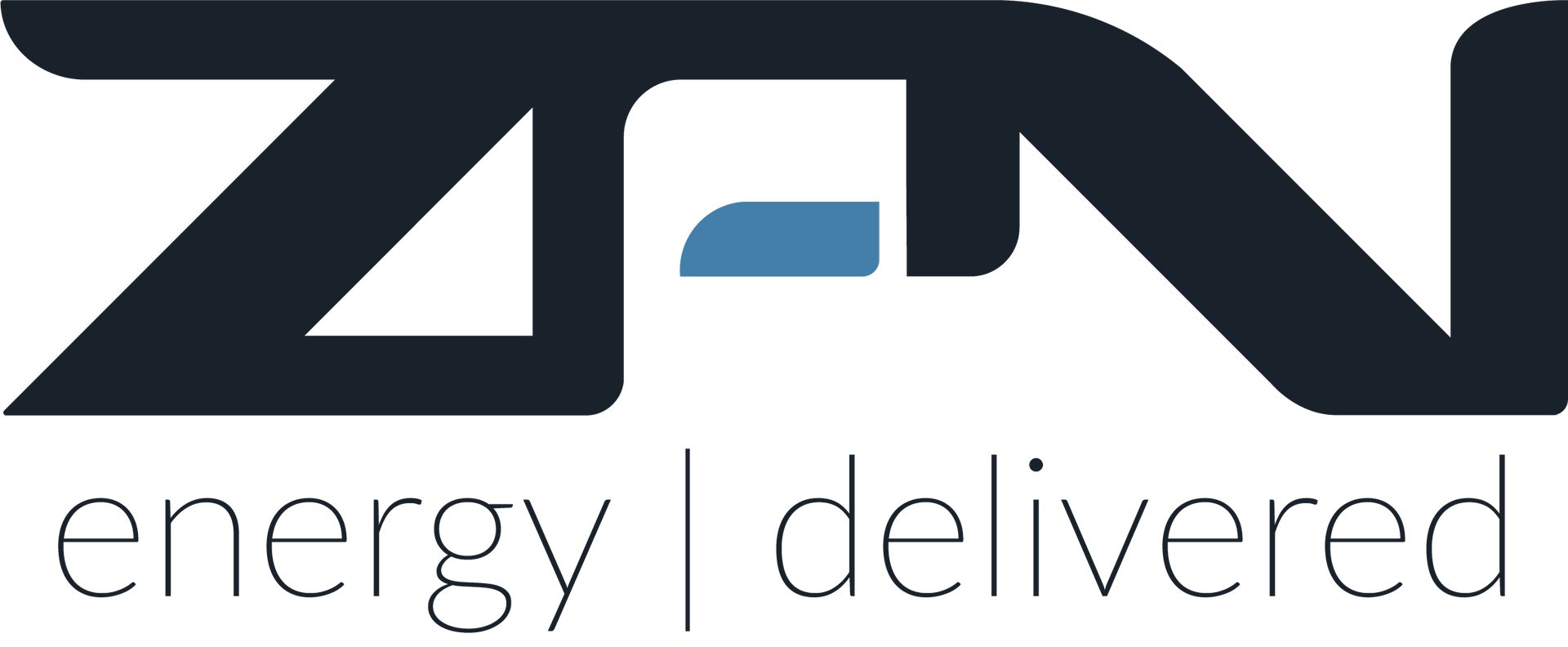Commercial Solar Battery Storage: Powering Your Business and EV Fleet
Think of commercial solar battery storage as your business's private energy reservoir. Instead of letting surplus solar power spill away you capture it on bright, sunny days and store it. You can then deploy that stored energy whenever you need it most—whether that’s during peak hours when grid electricity costs a fortune or when the sun isn't shining at all.
This simple shift in thinking is the key to finally getting a grip on your energy bills and building a more resilient business.
Powering The Future Of Business Energy
At its core, a commercial solar battery system isn’t just a big box that holds electricity. It’s an intelligent energy hub that brings together solar panels, an inverter, the battery itself and some very clever management software. This technology is quickly becoming a non-negotiable for UK businesses looking to break free from volatile energy markets and secure their own power supply.
The whole process is beautifully simple. Your solar panels soak up sunlight, generating direct current (DC) electricity. An inverter steps in to convert this into the alternating current (AC) power your equipment and lights run on. If you're generating more than you're using that excess energy doesn't get sold back to the grid for pennies—it gets stored in your battery for later.
Core Components And Their Roles
To really appreciate what these systems can do it helps to understand how the main parts work together. Each piece has a specific job in creating a reliable and financially savvy energy setup.
- Solar Panels: These are the workhorses, capturing sunlight to kickstart the whole process.
- Battery Unit: This is the heart of the operation, storing all that excess energy. Most modern systems use long-lasting lithium-ion technology.
- Inverter: Think of this as the system's translator. It flawlessly converts DC power from both the panels and the battery into the usable AC power your business needs.
- Management Software: This is the brain. The software makes smart, automated decisions about when to store power, when to use it from the battery and when to pull from the grid to absolutely maximise your savings.
A well-integrated system does so much more than just store power; it actively manages your site’s entire energy flow. It’s constantly optimising for cost, resilience and carbon reduction. This intelligent control is what turns a simple battery into a powerful business asset.
Expanding Beyond Simple Storage
The potential of commercial solar battery storage goes far beyond just shaving money off your electricity bill. The technology is a critical piece of the puzzle for modern energy demands, especially for any business dipping its toes into electric vehicles (EVs).
For businesses running EV fleets or offering customer charging a battery system acts as a buffer. It allows for rapid EV charging even if your site has a constrained grid connection , helping you avoid eye-watering grid upgrade costs and ensuring your chargers are always ready to go. This can also be applied to mobile EV charging solutions, providing power where it's needed most.
This approach combines on-site renewables, EV charging and batteries , effectively turning your business premises into its own distributed energy resource. These systems are the foundation for building stronger, local energy networks and are crucial for developing grid-scale batteries and a more resilient national infrastructure. You can explore more on how ZPN is pioneering distributed energy storage solutions that put power back in the hands of businesses.
It doesn’t stop with new systems, either. The idea of repurposing old electric vehicle batteries for this kind of stationary storage is gaining real momentum, with important discussions happening around understanding second-life EV battery regulations. This points to a growing circular economy within the energy world, promising an even more sustainable future.
Unlocking Financial and Operational Gains
Investing in a commercial solar battery storage system is no longer just about environmental credentials; it's a powerful financial strategy. For businesses across the UK this technology translates directly into tangible cost savings and opens up new revenue streams, creating a compelling return on investment that goes straight to your bottom line. It’s about taking firm control of your energy expenditure.
This proactive approach to energy management allows you to decide exactly when to use your stored solar power and when to draw from the grid. This capability is the key to unlocking major financial advantages. Two of the most immediate benefits come from what the industry calls 'peak shaving' and 'energy arbitrage' .
Peak shaving is a simple but incredibly effective tactic. Many commercial energy tariffs include steep demand charges, calculated based on your single highest point of electricity usage in a billing cycle. By deploying stored battery power during these moments of peak demand you effectively ‘shave’ that spike from your usage profile, directly cutting those costly charges.
This chart gives a clear picture of the typical financial returns businesses can expect from a commercial solar and battery storage system.
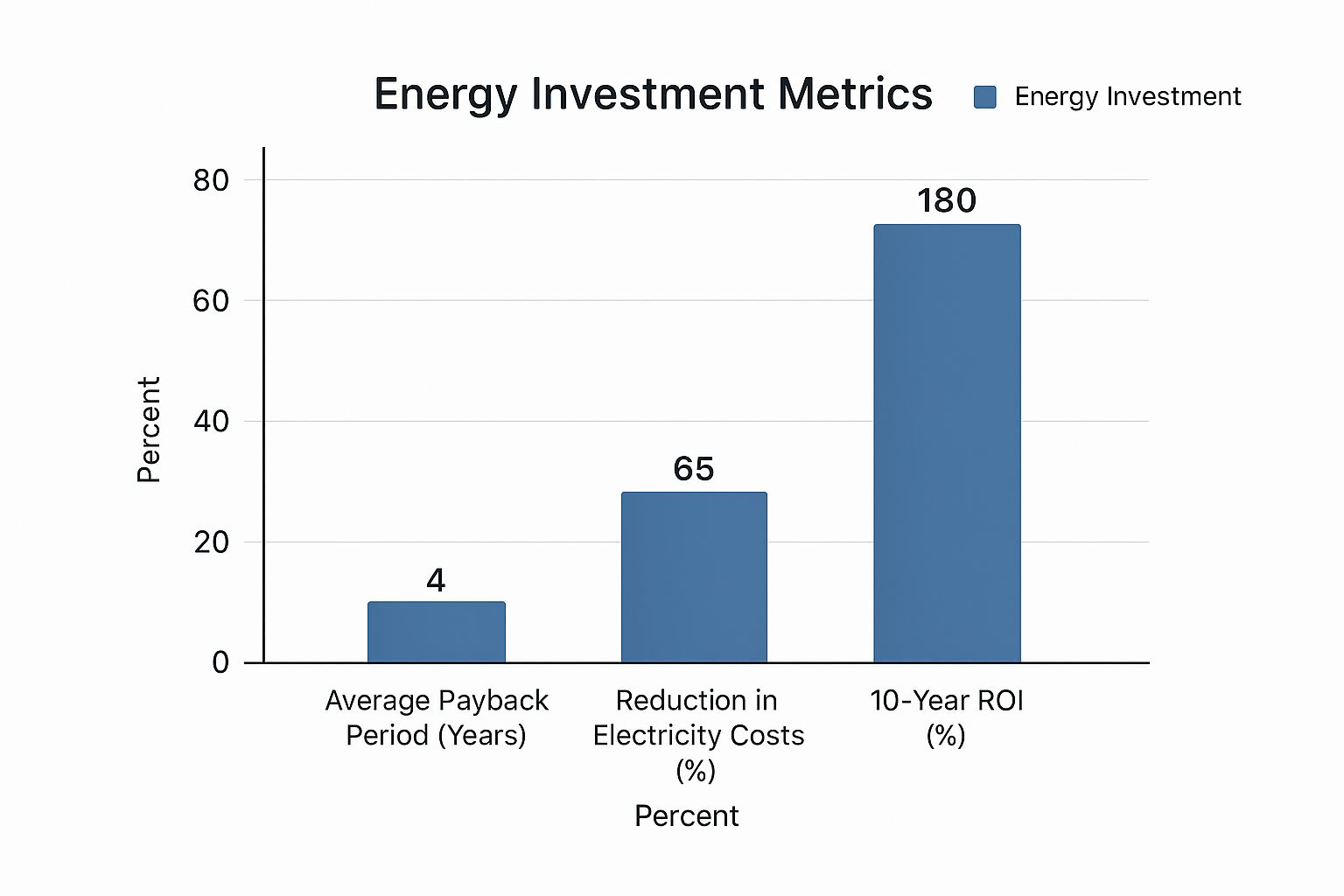
Mastering Energy Costs and Creating Revenue
Energy arbitrage works on a similar principle but plays on daily price fluctuations. Your intelligent system can be programmed to charge the battery during off-peak hours when grid electricity is cheapest, often overnight. You then use this low-cost stored energy during the day when tariffs are at their highest, maximising savings.
Here's a breakdown of the main financial levers a commercial battery system gives you:
Key Financial Benefits of Commercial Solar Storage
| Benefit | Mechanism | Financial Impact |
|---|---|---|
| Peak Shaving | Using stored battery power during periods of highest electricity demand to lower the 'peak' on your bill. | Directly reduces or eliminates expensive demand charges imposed by energy suppliers. |
| Energy Arbitrage | Charging the battery when grid electricity is cheap (e.g., overnight) and using or selling it when it's expensive. | Maximises savings on energy bills by shifting consumption away from peak tariff times. |
| Grid Services | Participating in National Grid schemes by providing power to help stabilise the grid. | Creates a new, predictable revenue stream by getting paid for frequency response and capacity. |
| Increased Solar Self-Consumption | Storing surplus solar energy generated during the day for use at night or on cloudy days. | Reduces reliance on the grid, cuts energy import costs and makes the most of your solar investment. |
Beyond simply saving money your commercial solar battery storage system can become a revenue-generating asset. By participating in grid services schemes your business can be paid to help the National Grid maintain stability.
- Frequency Response: Your battery can automatically inject or absorb small amounts of power to help keep the grid's frequency stable, a critical service for which you are compensated.
- Capacity Market: You can commit to providing power during periods of national peak demand, offering a reliable backup to the grid and earning a steady income stream in return.
This strategic approach is becoming essential as the UK’s energy landscape evolves. Solar power generation has surged and with it the need for robust storage solutions to manage this intermittent supply. The growth highlights the critical role of batteries in capturing surplus energy, balancing the grid and helping businesses offset rising electricity prices.
Enhancing Operational Resilience
The benefits aren't purely financial. A battery storage system also delivers incredible operational resilience, effectively acting as an uninterruptible power supply (UPS) for your entire operation. During a local power cut or grid failure the system can switch over instantly, keeping your critical systems running without a flicker.
For businesses where downtime is simply not an option—think data centres, manufacturing plants or cold storage facilities—this energy resilience is invaluable. It protects against lost productivity, data corruption and spoiled inventory, safeguarding your business continuity.
This dual benefit of financial gain and operational security makes commercial solar battery storage a cornerstone of modern business strategy. It reduces your exposure to volatile energy markets and provides a critical safety net. For businesses looking into these systems it's worth exploring the 10 advantages of modular energy storage to see how flexible designs can meet specific operational needs. By combining on-site renewables with intelligent storage you build a more robust and financially predictable future for your company.
Powering Your Renewables and EV Fleet
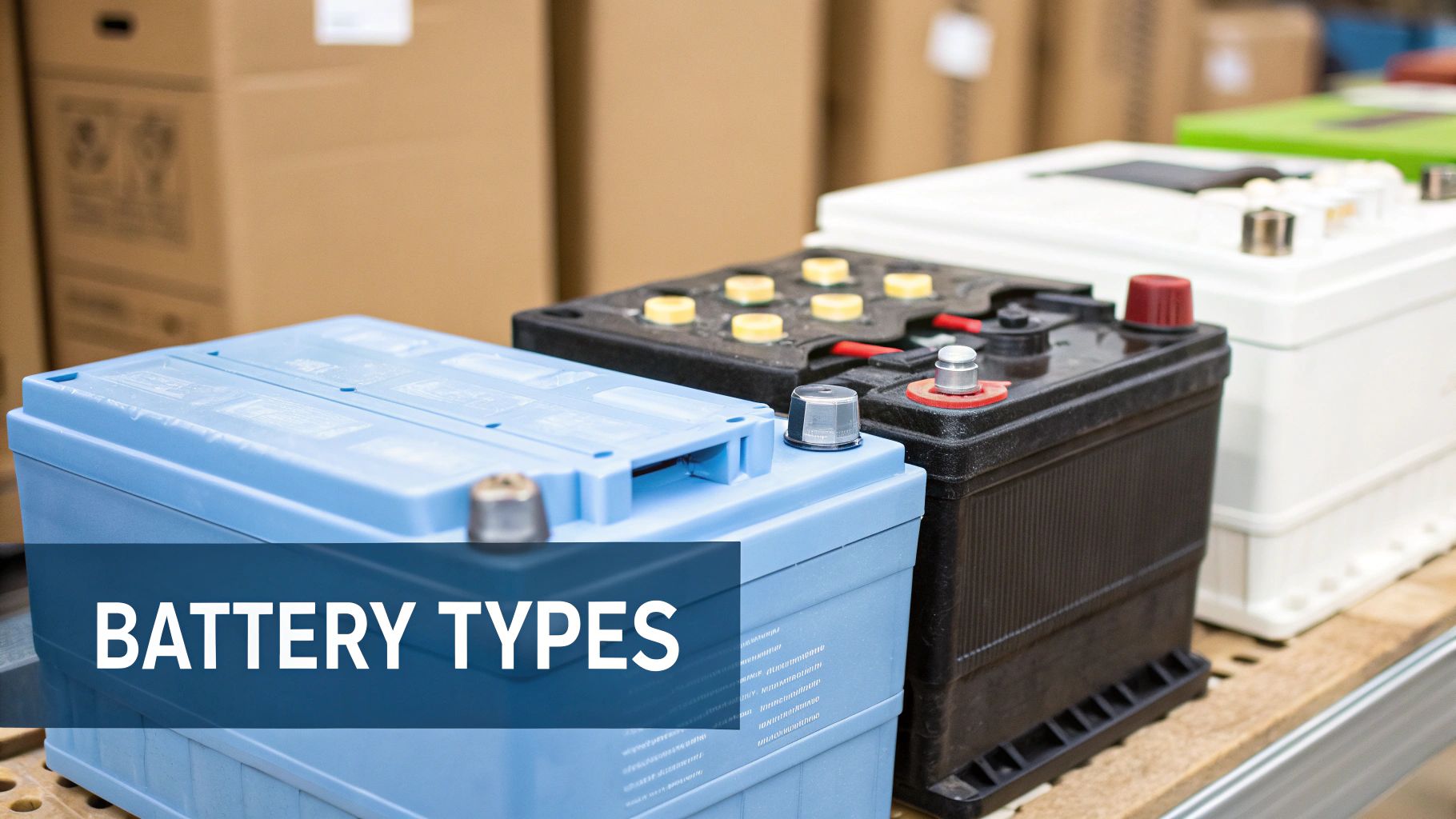
Pairing on-site renewables with an electric vehicle (EV) fleet is a powerful statement of sustainability for any business. But it presents a classic problem: solar panels generate the most power during the day yet fleet vehicles often need charging overnight. This is where commercial solar battery storage steps in to elegantly solve the mismatch.
Think of a battery system as an energy time-shifter. It captures all that abundant, low-cost solar energy your panels produce throughout the day and banks it. When your EV fleet rolls back into the depot in the evening that stored solar power is ready and waiting, delivering clean, cheap charging long after the sun has gone down.
This synergy does more than just power your vehicles; it transforms your site from a simple energy consumer into a self-sufficient energy hub. You can dramatically cut your reliance on expensive peak-rate grid electricity for fleet charging, slashing both your operational costs and your carbon footprint in one smart move.
Overcoming Grid Constraints for Rapid EV Charging
One of the biggest roadblocks businesses hit when looking to install EV chargers—especially rapid EV charging points—is the local grid connection. Drawing the huge amount of power needed for rapid charging can easily strain or even exceed the capacity of the existing infrastructure. The result? Quotes for grid upgrades that can run into the tens or even hundreds of thousands of pounds.
This is where a battery energy storage system (BESS) becomes an absolute game-changer. It acts as a powerful buffer between your chargers and the grid.
By storing energy the battery system can deliver the high power required for rapid charging without ever overloading your grid connection. It trickles energy from the grid to charge itself during low-demand periods and then releases it in a powerful burst when an EV plugs in.
This capability opens up the EV charging from constrained grid connections market to businesses that were previously locked out because of their location. You can install multiple high-power chargers for customers or your own fleet, even on sites with limited grid capacity. It’s an approach that avoids the costly, time-consuming nightmare of infrastructure upgrades, putting your transition to electric transport on the fast track.
Creating a Distributed Energy Ecosystem
When you integrate solar, batteries and EV charging you’re not just installing equipment; you’re creating a powerful local ecosystem. Your business stops being a passive endpoint on the National Grid and becomes an active player in a network of distributed energy resources. This setup is the bedrock of any modern, resilient energy strategy.
Just think about the applications this kind of integrated system makes possible:
- Mobile EV Charging Support: Battery systems can be used to support mobile EV charging units, providing off-grid power for events, remote work sites or even emergency recovery services.
- On-site Renewables Maximisation: You can ensure every single kilowatt-hour of solar energy you generate is put to good use, whether that's powering your operations directly or charging your vehicle fleet.
- Grid Scale Battery Integration: While your system serves your site it also has the potential to connect with larger networks of grid scale batteries , helping to stabilise the regional grid and even participate in grid services for an extra revenue stream.
This integrated model of EV charging and batteries is transforming the industry. It provides energy security, brings down costs and opens up entirely new commercial avenues. To see how this works in the real world you can learn more about how ZPN's battery storage systems are powering the UK's EV revolution.
The future of energy is decentralised and intelligent. For those interested in how national initiatives are shaping the future of battery technology this piece on Canada's Critical Battery Materials Initiative is a fascinating read. By combining on-site renewables with advanced storage your business can build a robust, future-proof energy infrastructure that supports both your operational needs and the wider shift to a low-carbon economy.
Supporting the Grid as a Distributed Energy Resource
Installing a commercial solar battery storage system does more than just power your business—it lets you play a vital role in strengthening the UK's national energy infrastructure. Your site shifts from being a simple energy consumer into an active participant in the grid, becoming what’s known as a Distributed Energy Resource (DER).
This idea completely flips the traditional energy model on its head. Instead of the country relying on a few huge, centralised power stations a DER network is made up of thousands of smaller, local energy assets just like yours. The result is a national grid that's more resilient, flexible and responsive.
When your battery system isn’t busy with on-site tasks like EV charging or peak shaving it can provide essential services back to the grid. This doesn’t just support the country’s energy security; it opens up sophisticated new revenue streams for your business.
From a Single Site to a Virtual Power Plant
On its own a single commercial battery is a powerful tool. But when you group multiple systems together and control them with intelligent software they become something much bigger: a Virtual Power Plant (VPP).
Think of a VPP as a digitally coordinated fleet of decentralised batteries. Working together this network can deliver the same grid-balancing services as a traditional power station but with far greater speed and precision. Being part of a VPP allows your business to collectively respond to signals from the National Grid.
A Virtual Power Plant pools the capacity of many individual commercial battery storage systems, allowing them to act as a single, large-scale energy resource. This collective power enables smaller businesses to participate in high-value grid services markets that were previously only accessible to major energy generators.
This cooperative model is critical for managing the modern grid. As more intermittent renewables like wind and solar come online the need for rapid-response balancing services is more important than ever. VPPs, powered by networks of commercial and grid-scale batteries , are perfectly placed to provide that stability.
The Impact on UK Energy Security
This decentralised model makes a huge difference to the UK's overall energy security. By spreading power generation and storage across thousands of business sites the grid becomes far less vulnerable to single points of failure, like an outage at a massive gas-fired power station.
This distributed energy network provides several key national benefits:
- Reduces Reliance on Fossil Fuels: It enables greater use of renewables by storing surplus wind and solar power, making clean energy available whenever it's needed.
- Enhances Grid Stability: A distributed network of batteries can react to frequency fluctuations in milliseconds, helping to prevent blackouts and keep the supply stable.
- Defers Costly Infrastructure Upgrades: By providing local power capacity DERs can ease the strain on regional substations and transmission lines, delaying the need for expensive upgrades.
The growth in this sector is impossible to ignore. The UK's commercial battery storage market is expanding rapidly, reflecting a national shift towards a more flexible and resilient grid. Data from the first half of 2025 showed a 78% increase in completed battery energy storage system (BESS) projects compared to H1 2024, with a massive project pipeline already approved. This trend is vital for meeting the UK's Clean Power 2030 goals. To get a sense of the scale of this growth you can learn more about the UK's soaring battery storage activity.
By investing in commercial solar battery storage your business isn't just making a smart financial move. You're contributing to a stronger, greener and more secure energy future for the entire country, accelerating the transition away from centralised, fossil-fuel-based power.
Your Guide to a Successful Deployment
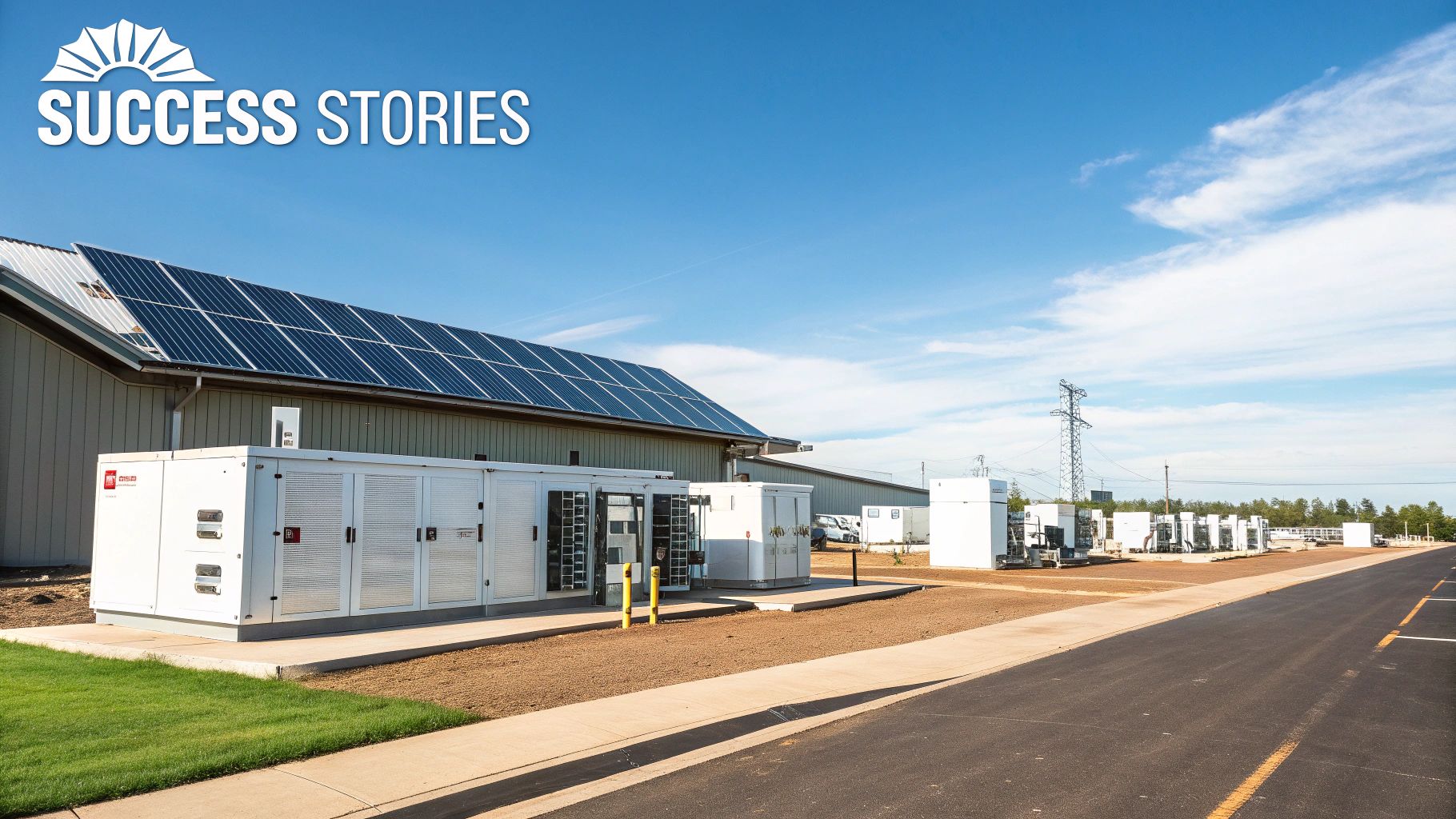
Deciding to install a commercial solar battery storage system is a major strategic move. Getting it right depends on careful planning across the technical, logistical and financial fronts. Nail these details from the start and you'll build an energy asset that not only meets but smashes your performance and investment goals.
This guide is your checklist for navigating the key stages. From choosing the right tech to finding a trustworthy installer every step is vital for creating a resilient and cost-effective energy system for your business.
Technical and Logistical Foundations
The first phase is all about getting to grips with your specific energy needs and the physical layout of your site. Sizing your system correctly is absolutely paramount. Go too small and you'll leave savings on the table; go too big and you'll have paid for capacity you never use.
A deep dive into your energy consumption patterns—including your peak demand and any EV charging loads—will point you to the ideal capacity (kWh) and power rating (kW) for your battery. This groundwork makes sure the system is perfectly tuned to the rhythm of your operations.
Once you have a clear picture of your needs a few key logistical steps come into play:
- Battery Chemistry: Most modern systems rely on lithium-ion technology, prized for its long life and efficiency. It’s worth discussing specific types like Lithium Iron Phosphate (LFP) with your installer though as it brings enhanced safety and durability to the table.
- Inverter Compatibility: The inverter is the heart of your system. It must be fully compatible with both your solar panels (new or existing) and the battery itself to ensure a seamless flow of energy.
- Physical Space: Commercial batteries need their own dedicated, temperature-controlled space. You'll need to scout your premises for a suitable spot that's secure, well-ventilated and easy to access for maintenance down the line.
Don’t underestimate the paperwork. Securing planning permissions and grid connection agreements with your local Distribution Network Operator (DNO) can be a lengthy process. It’s crucial to get these conversations started early to keep your project on track and avoid frustrating delays.
Financial Models and Installer Selection
With the technical specs locked in it's time to choose a financial model that fits your company's cash flow and long-term goals. There are a few well-trodden paths to acquiring a commercial solar battery storage system, each with its own perks.
- Outright Purchase: This requires the biggest upfront investment but it also delivers the maximum long-term financial returns. You own the asset outright, keeping all the savings and any revenue it generates.
- Leasing: A leasing agreement gets a system installed with little to no upfront cost. You simply make regular payments over a fixed term while enjoying lower energy bills from day one.
- Power Purchase Agreement (PPA): With a PPA a third party installs and maintains the system on your site at no cost to you. In return you agree to buy the electricity it produces at a fixed rate that’s cheaper than your current grid tariff, locking in guaranteed savings.
Choosing the right partner to install and commission your system is arguably the single most important decision you'll make. This isn't just any electrical job; your installer is responsible for the design, safety and performance of a complex, high-value asset.
It is absolutely essential to pick a reputable installer with Microgeneration Certification Scheme ( MCS ) credentials. MCS certification is the UK’s quality benchmark, ensuring your installer adheres to strict technical and safety standards. An MCS-certified partner guarantees your system is compliant, safe and eligible for any government incentives that might be available.
The UK market is embracing this technology at an incredible pace. The first half of 2025 saw a massive surge in adoption, with MCS reporting a record number of solar and battery installations. May 2025 alone saw nearly 3,400 certified battery storage installations—a staggering 112% increase year-on-year. This shows just how much confidence UK businesses have in this technology. You can discover more about the UK's record-setting solar and battery installations and see how your own project fits into this powerful national trend.
Answering Your Key Questions
As more businesses across the UK look to gain energy independence a few practical questions always come up. Before making a smart investment you need to understand the costs, the lifespan and whether a commercial solar battery is even right for you. Let's tackle the most common queries to give you the clarity you need.
How Much Does a Commercial Solar Battery System Cost?
There's no single price tag. The cost of a commercial battery system depends heavily on its storage capacity (measured in kWh), its power output (kW), the technology inside and the brand you choose. It's much more than just the battery units; think of it as a complete package that includes the inverter, smart management software and professional installation.
While it is a significant capital investment the financial case gets a lot stronger when you factor in the support available. UK businesses can often find grants, tap into tax incentives like capital allowances and use flexible financing to dramatically lower the upfront cost.
The real story though is the return on that investment. It shows up in radically lower energy bills, insulation from wild price swings and even new revenue streams from supporting the grid. For most businesses a combined solar and storage project pays for itself within 5 to 10 years . After that the energy you produce is almost pure profit.
What Is the Lifespan of a Commercial Battery?
Today's commercial batteries are built to last. The vast majority of systems use lithium-ion technology—the industry standard—and come with a manufacturer's warranty of 10 to 15 years or are rated for a set number of charge-discharge cycles. This longevity is no accident; it’s designed to match the typical 25-year lifespan of solar panels, making sure your entire energy system works together for decades.
A few things can influence how long a battery performs at its best:
- Depth of Discharge (DoD): Constantly running a battery flat will shorten its life. Modern software is smart enough to prevent this, keeping it at an optimal charge level.
- Operating Temperature: Batteries are happiest in stable, controlled environments. Extreme heat or cold can impact performance, which is why choosing the right location is so important.
- Cycling Frequency: How often the battery is charged and discharged matters but they are absolutely designed for daily, heavy use.
It's important to know that a battery's performance fades gradually, a bit like your mobile phone's. It doesn't just stop working one day. This predictable degradation means it remains a reliable and valuable asset well into its operational life.
Can I Retrofit a Battery to My Existing Solar Panels?
Yes, absolutely. Adding battery storage to an existing solar PV system is a common and surprisingly straightforward job. If your business already has panels on the roof you can integrate a battery to start storing all that surplus energy instead of selling it back to the grid for pennies.
This is usually done through a method called ‘AC-coupling’ . An AC-coupled system simply adds a separate, dedicated battery inverter next to your existing solar inverter. This setup allows the battery to do its thing—charging and discharging—without messing with your current solar array. It's a highly efficient and cost-effective way to upgrade your system. A qualified installer can take one look at your setup and map out the best way to do it.
How Do I Know If My Business Is a Good Fit?
While almost any business can find value in battery storage some are practically tailor-made for it. The only way to know for sure is with an energy audit but you're likely a perfect candidate for commercial solar battery storage if any of these sound familiar:
- You use a lot of electricity, especially in the early mornings or evenings when the sun isn't at its peak.
- Your energy bills are inflated by expensive peak demand charges.
- You run an EV fleet or want to install rapid EV charging for staff and customers, particularly if you have a constrained grid connection .
- Your operations can't afford to stop. Any power outage means a serious loss of money or data.
- You have serious Environmental, Social and Governance (ESG) goals and want a concrete way to shrink your carbon footprint.
If you found yourself nodding along then exploring a solution combining on-site renewables, EV charging and batteries could be one of the smartest strategic moves you make for your business's bottom line and future resilience.
Ready to take control of your energy future with a fully integrated solar, battery storage and EV charging solution? Contact ZPN Energy today to discover how our British-engineered systems can cut your costs and power your growth. Learn more at https://www.zpnenergy.com.


